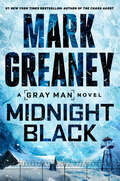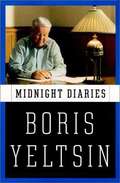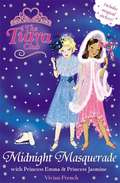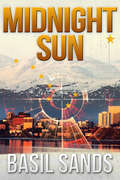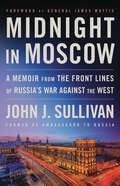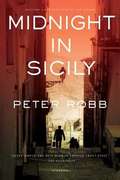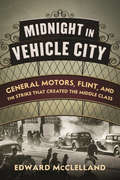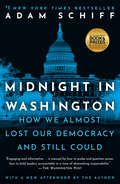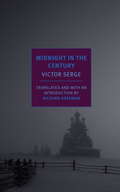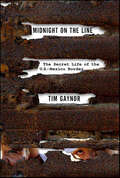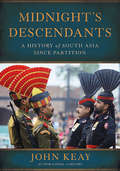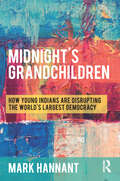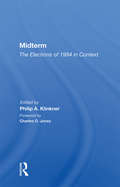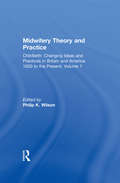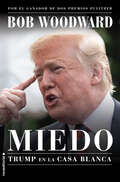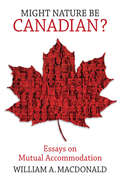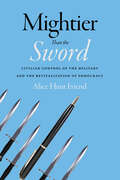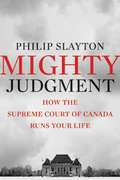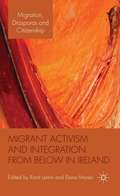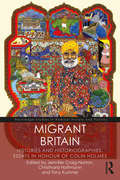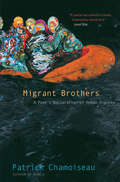- Table View
- List View
Midnight Black (Gray Man)
by Mark GreaneyWith his lover imprisoned in a Russian gulag, the Gray Man will stop at nothing to free her in this latest entry in the #1 New York Times bestselling series.A winter sunrise over the great plains of Russia is no cause for celebration. The temperature barely rises above zero, and the guards at Penal Colony IK22 are determined to take their misery out on the prisoners—chief among them, one Zoya Zakharova. Once a master spy for Russian foreign intelligence, then the partner and lover of the Gray Man, she has information the Kremlin wants, and they don't care what they have to do to get it.But if they think a thousand miles of frozen wasteland and the combined power of the Russian police state is enough to protect them, they don't know the Gray Man. He's coming, and no one's safe. <p> <b>New York Times Bestseller</b>
Midnight Diaries
by Catherine A. Fitzpatrick Boris Yeltsin<P>Midnight Diaries is Boris Yeltsin's pithy, personal, and revealing account of the struggles and upheavals in Russia over the last several years, seen from the perspective of the man whose job it was to pull all the strings together. <P>Growing out of a series of late-night conversations between Mr. Yeltsin and his chief of staff, the book addresses with astounding candor subjects including: the real impact of the coup of 1991; the process of decision-making about Chechnya; Yeltsin's relationships with world leaders including Bill Clinton, Helmut Kohl, Jacques Chirac, Zhao Zemin, and Tony Blair; the real story behind the string of prime ministers he hired and then dismissed; the Russian economy and allegations of corruption; his own health; and his decision to retire from the presidency. <P>Vivid and direct in the style of Yeltsin himself, Midnight Diaries is an unprecedented look inside the tumultuous politics of a changing Russia. Its publication is an international publishing event.
Midnight Masquerade (Tiara Club)
by Vivian FrenchA winning combination of princess glamour, school stories, friendship and magic. Princess Emma and Princess Jasmine are visiting the Tiara Club Academy to discover if they like it.
Midnight Sun
by Basil SandsA former US government agent goes rogue in this nonstop thrill ride from an author who “is fearless in his storytelling” (Scott Sigler, #1 New York Times–bestselling author). They should’ve let him go. They should’ve let him retire in peace. They should’ve left his woman out of it.Kharzai Ghiassi has served the US Government his entire adult life. The best infiltration agent they’ve ever had. Death is not just his business, death is his life. He’s gone off the CIA’s radar and all they know is that someone is in danger.When a former soccer star turned Islamic terrorist shows up in Anchorage, Alaska, retired Marine Corps Special Operator Marcus ‘Mojo’ Johnson and his State Trooper wife, Lonnie, team up with the FBI’s Mike and Hilde Farris to put a stop to the threat that hangs over the city like a hammer about to fall. No one is safe. No one can hide in the Land of the Midnight Sun.Praise for Basil Sands and his thrillers“One awesome writer, penning stories pumped with enough adrenaline that you’ll suffer from insomnia until you read the last word. This is one writer not to be missed.” —Jeremy Robinson, New York Times–bestselling author“Basil Sands’s Ice Hammeris a gripping, can’t-put-it-down series that works at every level. It’s got it all: love, war, treachery, and heroism. A home run!” —John Gilstrap, New York Times–bestselling author“Basil Sands has a knack for blending action and intrigue in an all-too realistic setting . . . I just hope there are heroes like Basil’s heroes fighting on our side.” —Evo Terra, founder of Podiobooks.com
Midnight in Moscow: A Memoir from the Front Lines of Russia's War Against the West
by John J. SullivanA memoir of service by the American ambassador who was on the diplomatic front lines when Putin invaded Ukraine, Midnight in Moscow is the first behind-the-scenes account of how U.S.-Russia relations hit their nadir—and a playbook for our unfolding confrontation. For weeks before Russia&’s invasion of Ukraine, John J. Sullivan, the U.S. ambassador in Moscow, was warning that it would happen. When troops finally crossed the border, he was woken in the middle of the night with a prearranged code. The signal was even more bracing than the February cold: it meant that Sullivan needed to collect his bodyguards and get to the embassy as soon as possible. The war had begun, and the world would never be the same. In Midnight in Moscow, Sullivan leads readers into the offices of the U.S. embassy and the halls of the Kremlin during this climactic period—among the most dangerous since World War II. He shows how the Putin regime repeatedly lied about its intentions to invade Ukraine in the weeks leading up to the attack, while also devoting huge numbers of personnel and vast resources to undermining the U.S. diplomatic mission in Russia. And he explains how, when Putin ultimately gave the order to launch a full-scale invasion of Ukraine on February 24, 2022, he proved that Russia was not just at war with its neighbor: it was also at war, in a very real sense, with the United States, and with everything that it represents. But while Putin decided how this conflict started, its ending will be shaped by us. With his unique perspective on a pivotal moment in world history, Sullivan shows how our relationship with Russia has deteriorated, where it&’s headed, and how far we should be prepared to go in standing up to the menace in Moscow.
Midnight in Samarra: The True Story of WMD, Greed, and High Crimes in Iraq
by Eleanor Cooney Frank Gregory FordThe riveting, exclusive true story of an Iraq whistleblower who continues to be betrayed by his country, as told by an international bestselling author. Gregory Ford, an intelligence agent and medic, was in Iraq for only a short time—from the invasion in March 2003 until early June of the same year, when he was strapped to a stretcher, drugged, and “renditioned” out of Iraq in a clandestine and criminal operation at the behest of his command, who were frantically trying to silence him. But why? Midnight in Samarra is the shocking true story of one soldier’s attempt to speak up and report the abuse and torture he saw being inflicted on the local population, as well as secret, incriminating, enormous Iraqi arms stores of American-made Weapons of Mass Destructionwith bills of lading implicating, among others, famous political families. His warnings about simmering anti-American fury of the local populace were ignored and suppressed by his command; hundreds of millions of dollars in cash seized in the home of Saddam Hussein’s main banker as a result of Ford's intelligence work vanished without a trace. Ford’s information about Hussein’s location, which could have led to the dictator's apprehensionsix months before his actual capture,was also ignored and suppressed. As Ford was filing charges against his superior officers, they seized his weapons (illegal in a war zone), tried to declare him insane, abducted him by force, restrained him, administered a dangerous mind-altering drug during a Medevac flight, and tried to interrogate him while he was under. Years later, Gregory Ford is still trying to get justice. His command—and high-ups in both the military and the government—lied, dissembled, obfuscated, danced, and dodged while Ford endured libel, slander, and innuendo, feared for his life, and, nearly a decade after the drugging on the plane, learned that the chemical injected into him had done permanent damage to his heart and nervous system.Midnight in Samarra is the story of one man’s courage and conviction, and the horrifying truths of one of our most trusted and honored institutions.
Midnight in Sicily
by Peter RobbSouth of mainland Italy lies the island of Sicily, home to an ancient culture that--with its stark landscapes, glorious coastlines, and extraordinary treasure troves of art and archeology--has seduced travelers for centuries. But at the heart of the island's rare beauty is a network of violence and corruption that reaches into every corner of Sicilian life: Cosa Nostra, the Mafia. Peter Robb lived in southern Italy for over fourteen years and recounts its sensuous pleasures, its literature, politics, art, and crimes.
Midnight in Vehicle City: General Motors, Flint, and the Strike That Created the Middle Class
by Edward McClellandIn a time of great inequality and a gutted middle class, the dramatic story of "the strike heard around the world" is a testament to what workers can gain when they stand up for their rights.The tumultuous Flint sit-down strike of 1936-1937 was the birth of the United Auto Workers, which set the standard for wages in every industry. Midnight in Vehicle City tells the gripping story of how workers defeated General Motors, the largest industrial corporation in the world. Their victory ushered in the golden age of the American middle class and created a new kind of America, one in which every worker had a right to a share of the company's wealth. The causes for which the strikers sat down--collective bargaining, secure retirement, better wages--enjoyed a half century of success. But now, the middle class is disappearing and economic inequality is at its highest since before the New Deal. Journalist and historian Edward McClelland brings the action-packed events of the strike back to life--through the voices of those who lived it. In vivid play-by-plays, McClelland narrates the dramatic scenes including of the takeovers of GM plants; violent showdowns between picketers and the police; Michigan governor Frank Murphy's activation of the National Guard; the actions of the militaristic Women's Emergency Brigade who carried billy clubs and vowed to protect strikers from police; and tense negotiations between labor leader John L. Lewis, GM chairman Alfred P. Sloan, and labor secretary Frances Perkins.The epic tale of the strike and its lasting legacy shows why the middle class is one of the greatest inventions of the 20th century and will guide our understanding of what we will lose if we don't revive it.
Midnight in Washington: How We Almost Lost Our Democracy and Still Could
by Adam SchiffFrom the congressman who led the first impeachment of Donald J. Trump, the vital inside account of American democracy in its darkest hour, and a warning that the forces of autocracy unleashed by Trump remain as potent as ever. <p><p> In the years leading up to the election of Donald Trump, Congressman Adam Schiff had already been sounding the alarm over the resurgence of autocracy around the world, and the threat this posed to the United States. But as he led the probe into Donald Trump’s Russia and Ukraine-related abuses of presidential power, Schiff came to the terrible conclusion that the principal threat to American democracy now came from within. In Midnight in Washington, Schiff argues that the Trump presidency has so weakened our institutions and compromised the Republican Party that the peril will last for years, requiring unprecedented vigilance against the growing and dangerous appeal of authoritarianism. <p><p> The congressman chronicles step by step just how our democracy was put at such risk, and traces his own path to meeting the crisis—from serious prosecutor, to congressman with an expertise in national security and a reputation for bipartisanship, to liberal lightning rod, scourge of the right, and archenemy of a president. Schiff takes us inside his team of impeachment managers and their desperate defense of the constitution amid the rise of a distinctly American brand of autocracy. Deepening our understanding of prominent public moments, Schiff reveals the private struggles, the internal conflicts, and the triumphs of courage that came with defending the republic against a lawless president—but also the slow surrender of people that he had worked with and admired to the dangerous immorality of a president engaged in an historic betrayal of his office. <p><p> Schiff’s fight for democracy is one of the great dramas of our time, told by the man who became the president’s principal antagonist. It is a story that began with Trump but does not end with him, taking us through the disastrous culmination of the presidency and Schiff’s account of January 6, 2021, and how the anti-democratic forces Trump unleashed continue to define his party, making the future of democracy in America more uncertain than ever.
Midnight in the Century
by Victor Serge Richard GreemanIn 1933, Victor Serge was arrested by Stalin's police, interrogated, and held in solitary confinement for more than eighty days. Released, he spent two years in exile in remote Orenburg. These experiences were the inspiration for Midnight in the Century, Serge's searching novel about revolutionaries living in the shadow of Stalin's betrayal of the revolution. Among the exiles gathered in the town of Chenor, or Black-Waters, are the granite-faced Old Bolshevik Ryzhik, stoic yet gentle Varvara, and Rodion, a young, self-educated worker who is trying to make sense of the world and history. They struggle in the unlikely company of Russian Orthodox Old Believers who are also suffering for their faith. Against unbelievable odds, the young Rodion will escape captivity and find a new life in the wild. Surviving the dark winter night of the soul, he rediscovers the only real, and most radical, form of resistance: hope.
Midnight on the Line: The Secret Life of the U.S.-Mexico Border
by Tim GaynorA probing, ground-level investigation of illegal immigration and the people on both sides of the battle to secure the U.S.–Mexico borderWith illegal immigration burning as a contentious issue in American politics, Reuters reporter Tim Gaynor went into the underbelly of the border and to the heart of illegal immigration: along the 45-mile trek down the illegal alien "superhighway." Through scorpion-strewn trails with Mexican migrants and drug smugglers, he met up with a legendary group of Native American trackers called the Shadow Wolves, and traveled through the extensive network of tunnels, including the "Great Tunnel" from Tijuana to Otay Mesa, California. Along the way, Gaynor also meets Minutemen and exposes corruption among the Border Patrol agents who exchange sex or money for helping smugglers. The issue of illegal immigration has a complexity beyond any of the political rhetoric. Combining top-notch investigative journalism with a narrative style that delves into the human condition, Gaynor reveals the day-to-day realities on both sides of "the line."
Midnight on the Mavi Marmara: The Attack on the Gaza Freedom Flotilla and How It Changed the Course of the Israeli/Palestine Conflict
by Moustafa BayoumiAt 4:30 AM on Monday, May 31, 2010, Israeli commandos, boarding from sea and air, attacked the six boats of the Gaza Freedom Flotilla as it sailed through international waters attempting to bring humanitarian relief to the beleaguered Palestinians of Gaza. Within minutes, nine peace activists were dead, shot by the Israelis. Scores of others were injured. Within hours, outrage at Israel's action echoed around the world. Spontaneous demonstrations occurred in Europe, the United States, Turkey, and Gaza itself to denounce the attack. Turkey's prime minister described it as a "bloody massacre" and "state terrorism." In these pages, a range of activists, journalists, and analysts piece together the events that occurred that May night. Mixing together first-hand testimony and documentary record with hard-headed analysis and historical overview, Midnight on the Mavi Marmara reveals why the attack on the Gaza Freedom Flotilla may just turn out to be Israel's Selma, Alabama moment: the beginning of the end for an apartheid Palestine.
Midnight's Descendants: A History of South Asia since Partition
by John KeayA celebrated historian presents a history of Southern Asia since the Partition of British India in 1947, revealing how the twin forces of democracy and extremism are shaping the regionOCOs future. "
Midnight’s Grandchildren: How Young Indians are Disrupting the World's Largest Democracy
by Mark HannantWhile the west has experienced multiple post-war economic, social and political revolutions, India by contrast has had two distinct moments of transformation in the past century: Independence in 1947 and the economic liberalisation that began in 1991. Midnight’s Grandchildren are the offspring of India’s second social and economic revolution. India’s millennial generation, coming of age post-1991, have grown up in a world of opportunity and relative abundance. Many institutions – family, marriage, workplace, and brands – are being disrupted. Great tension exists as a new generation breaks barriers and seeks to find its place. This book captures an important, transformative moment in India’s development. It includes interviews with young Indians who articulate both their optimism and the struggle to find relevant new identities. Managers and recruiters speak about the changes in the workplace and the challenges and opportunities of harnessing India’s so-called demographic dividend. Entrepreneurs, brand owners and marketers discuss the role of brands in cementing identities in a world changing rapidly where loyalty has little meaning. Midnight’s Grandchildren explains for a business audience the significance of the arrival in the workforce of a generation of millennials as both disruptors of the old order and engine of India’s future economic potential. It is of use for professionals and educators wanting to engage this vitally important group of young people.
Midterm: The Elections Of 1994 In Context
by Philip A. KlinknerBy all accounts, 1994 represents sweeping electoral and policy change rarely seen in any American election, let alone a midterm. This book puts 1994 in context with other significant midterm elections, from 1810 to the present. It also captures the very contemporary concerns unique to 1994: the role of the religious right, the "angry white male," t
Midwest-Reading Essentials in Social Studies
by Purcell Martha SiasThis book looks at the geography, history, resources, and people of the Midwest region of the United States.
Midwifery Theory and Practice (Childbirth: Changing Ideas and Practices in Britain and America 1600 to the Present #1)
by Philip K. WilsonFirst Published in 1996. Routledge is an imprint of Taylor & Francis, an informa company.
Miedo. Trump en la Casa Blanca
by Bob WoodwardLa historia del presidente Trump como solo Bob Woodward podía contarla. Con la autoridad de haber informado a lo largo de ocho presidencias, desde Nixon hasta Obama, Bob Woodward revela con un detalle sin precedentes la horrible verdad del día a día en la Casa Blanca del presidente Donald Trump, precisando cómo es su toma de decisiones en las principales políticas internas y exteriores. Woodward analiza cientos de horas de entrevistas a fuentes de primera mano, notas de reuniones, diarios personales, archivos y documentos. El libro hace especial hincapié en los polémicos debates y en las decisiones que se toman en el despacho oval, la sala de situaciones, el Air Force One y en la residencia oficial de La Casa Blanca. Miedo es el retrato más íntimo sobre un presidente en activo jamás publicado anteriormente durante sus primeros años en la Casa Blanca. La crítica ha dicho...«Woodward describe la Casa Blanca de Trump como una operación bizantina, traicionera y fuera de control.»Mark Landler y Maggie Haberman, New York Times «Un informe devastador sobre la presidencia de Trump que será consultado durante muchos años. Lo que Woodward ha escrito no es tan solo la historia de un presidente profundamentecuestionado, sino también un relato alrededor de aquellos que le apoyaron y eligieron.»Susan B. Glasser, The New Yorker «El gran libro de no ficción del año, no sólo por esperado, sino también por sus revelaciones, rigurosas, documentadas y de testimonios de primera mano del Despacho Oval o las reuniones de trabajo a bordo del Air Force One.»Matías Néspolo, El Mundo«Un preciso retrato periodístico de la Casa Blanca basado en un centenar de fuentes que se lee como un guión cinematográfico a golpe de realidad.»Dori Toribio, analista política y corresponsal en Washington «El libro dibuja un escenario de locura dentro del Gobierno del país más poderoso del mundo.»Amanda Mars, El País
Might Nature Be Canadian?: Essays on Mutual Accommodation
by William A. MacdonaldMutual accommodation is about co-operation, compromise, and inclusion. It's a big idea, equal to freedom, science, and compassion. The postwar global economic order led by the United States is one of the greatest historic achievements of mutual accommodation, yet it is now at risk from the centrifugal forces that have led to populism. Today, to many nations and people, Canada is the model country driven by successful mutual accommodation. In Might Nature Be Canadian? William Macdonald explores the theme of mutual accommodation with a close lens on the Canadian experience. Canada has a drive toward mutual accommodation. The United States has a strong drive toward division. There has always been a divergence of ideologies between the two countries. The United States now appears to view the world as a never-ending struggle, which has become greater since 2000, between good and evil, while Canada, by contrast, leans toward the idea that there is an underlying order at the heart of things. Canada has always faced strong limits in creatively overcoming a challenging geography and French/English language differences within its own borders; on the other hand the United States sees itself as a country with virtually no limits. Throughout its history Canada's drive toward mutual accommodation, stronger than that of any other country, has allowed its increasingly diverse citizens to live together peacefully and successfully, even as they retain their own culture, language, and religion. Nature can be described as simultaneously either/or and both/and. Is there something fundamentally Canadian about this? Taking inspiration from British philosopher Alfred North Whitehead, who said that "civilization is the triumph of persuasion over force," Macdonald argues that the urgent spread of mutual accommodation, a charge led by Canada, is central to achieving a bearable world for everyone.
Might Nature Be Canadian?: Essays on Mutual Accommodation
by William A. MacdonaldMutual accommodation is about co-operation, compromise, and inclusion. It's a big idea, equal to freedom, science, and compassion. The postwar global economic order led by the United States is one of the greatest historic achievements of mutual accommodation, yet it is now at risk from the centrifugal forces that have led to populism. Today, to many nations and people, Canada is the model country driven by successful mutual accommodation. In Might Nature Be Canadian? William Macdonald explores the theme of mutual accommodation with a close lens on the Canadian experience. Canada has a drive toward mutual accommodation. The United States has a strong drive toward division. There has always been a divergence of ideologies between the two countries. The United States now appears to view the world as a never-ending struggle, which has become greater since 2000, between good and evil, while Canada, by contrast, leans toward the idea that there is an underlying order at the heart of things. Canada has always faced strong limits in creatively overcoming a challenging geography and French/English language differences within its own borders; on the other hand the United States sees itself as a country with virtually no limits. Throughout its history Canada's drive toward mutual accommodation, stronger than that of any other country, has allowed its increasingly diverse citizens to live together peacefully and successfully, even as they retain their own culture, language, and religion. Nature can be described as simultaneously either/or and both/and. Is there something fundamentally Canadian about this? Taking inspiration from British philosopher Alfred North Whitehead, who said that "civilization is the triumph of persuasion over force," Macdonald argues that the urgent spread of mutual accommodation, a charge led by Canada, is central to achieving a bearable world for everyone.
Mightier Than the Sword: Civilian Control of the Military and the Revitalization of Democracy
by Alice Hunt FriendThe civilian role in managing the military has never been more important. Today, civilian leadership of defense policy is challenged by the blurring line between war and competition and the speed of machine decision-making on the battlefield. Moreover, the legitimacy of political leaders and civil servants has been undermined by a succession of foreign policy failures and by imbalances of public faith in the military on the one hand and disapproval of civilian institutions on the other. A central question emerges: What does appropriate and effective civilian control of the military look like? Combining scholarly expertise and firsthand civilian experience in the Department of Defense, Friend argues that civilians combine authoritative status, institutional functions, and political expertise to ensure that democratic preferences over the use of force prevail. Friend focuses on the ways political context shapes whether and how civilian controllers—the civilians in professional and institutional positions with the responsibility for defense matters—exercise control over the military and each other. Mightier Than the Sword provides insights that enrich civil-military relations scholarship, as well as lessons aimed at revitalizing American democracy.
Mighty Judgment
by Philip SlaytonIn "Mighty Judgment" Philip Slayton describes the important issues the Supreme Court decides for individual Canadians and for Canada as a nation, and the surprising and dramatic ways in which these decisions shape our future. In the Morgentaler case (1988), the court struck down laws restricting abortion, leaving Canada the only Western country without any abortion laws. In the Same-Sex Marriage Reference (2004), it decided that gays and lesbians could marry. In the Secession Reference (1998), it laid down the conditions under which Quebec could secede from Canada. In the Patrick case (2009), the court decided that the right of privacy does not stop the police from rifling through our garbage. More recently, the court administered a tongue-lashing to the federal government over its treatment of Canadian youth Omar Khadr, accused by the United States government of fighting with the Taliban. "Mighty Judgment" makes clear that the Supreme Court of Canada is a political institution, and that judges are politicians. But unlike other politicians, judges cannot be voted out of office. Slayton discusses reforms that will be needed, particularly in the way judges are chosen, once we recognize that the court decides policy and plays a pivotal role in governing Canada.
Migrant Activism and Integration from Below in Ireland
by Ronit Lentin Elena MoreoThis book analyzes the interaction between migrant activists and leaders and the state of the Republic of Ireland - a late player in Europe's immigration regime - against the background of an increasingly restrictive immigration regime.
Migrant Britain: Histories and Historiographies: Essays in Honour of Colin Holmes (Routledge Studies in Radical History and Politics)
by Tony Kushner Jennifer Craig-Norton Christhard HoffmannBritain has largely been in denial of its migrant past - it is often suggested that the arrivals after 1945 represent a new phenomenon and not the continuation of a much longer and deeper trend. There is also an assumption that Britain is a tolerant country towards minorities that distinguishes itself from the rest of Europe and beyond. The historian who was the first and most important to challenge this dominant view is Colin Holmes, who, from the early 1970s onwards, provided a framework for a different interpretation based on extensive research. This challenge came not only through his own work but also that of a 'new school' of students who studied under him and the creation of the journal Immigrants and Minorities in 1982. This volume not only celebrates this remarkable achievement, but also explores the state of migrant historiography (including responses to migrants) in the twenty-first century.
Migrant Brothers: A Poet's Declaration of Human Dignity
by Patrick Chamoiseau Matthew Amos Fredrik Rönnbäck“If justice had a Jericho trumpet, Chamoiseau would be it.”—Junot Díaz <P><P>As migrants embark on perilous journeys across oceans and deserts in pursuit of sanctuary and improved living conditions, what is the responsibility of those safely ensconced in the nations they seek to enter? <P>Moved by repeated tragedies among immigrants attempting to enter eastern and southern Europe, Patrick Chamoiseau assails the hypocrisy and detachment that allow these events to happen. Migrant Brothers is an urgent declaration of our essential interconnectedness that asserts the necessity to understand one another as part of one human community, regardless of national origin.
